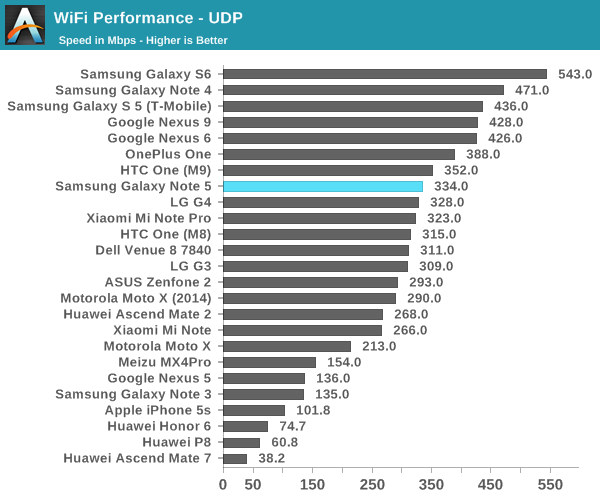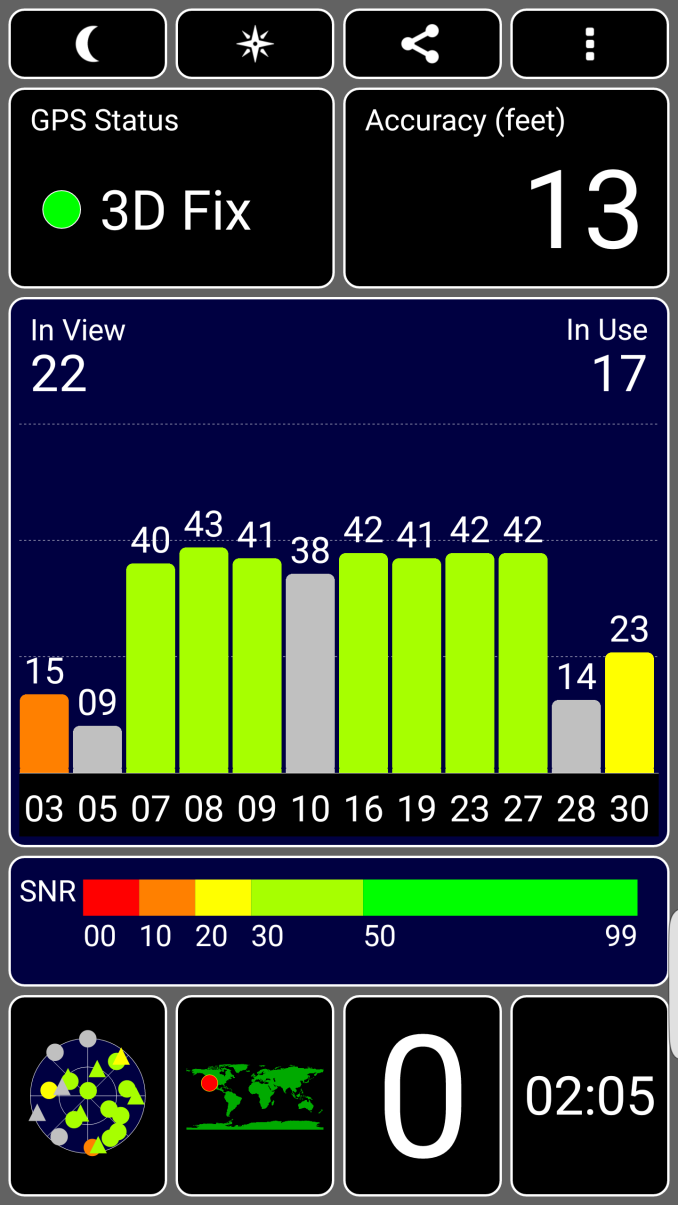The Samsung Galaxy Note5 and Galaxy S6 edge+ Review
by Joshua Ho on October 2, 2015 8:00 AM ESTVideo Performance
Now that we’ve taken a look at still image performance, we can look at video performance. For the most part these results should be similar to still image performance, but we’re looking at encoder efficiency, good sound recording, and effective stabilization. The Galaxy Note5 and Galaxy S6 edge+ both have OIS in order to improve stability in video recording, and for the most part the feature set of both is similar to the Galaxy S6 when it comes to video.
Galaxy Note5
Galaxy S6
Galaxy Note5
iPhone 6
For 1080p30, Samsung has elected to use 17Mbps High Profile H.264, along with a 256 Kbps stereo audio channel encoded with AAC. If this sounds familiar, it's because this is shared with the Galaxy S6. Quality is indistinguishable. Unfortunately, it seems the same sort of jerky OIS reset effect is still present although it isn't too obvious in these videos.
Galaxy S6
iPhone 6
It probably goes without saying, but once again the Galaxy Note5 shares the same video encode settings with the Galaxy S6, with 28 Mbps High Profile H.264 encoding for 1080p60 video. In these samples you can more clearly see the issues that come with OIS in video, which is that there are instances of jerky video movement when it should be relatively smooth, even if it's shaky. The only real difference between the Galaxy S6 and Note5/S6 edge+ is that the Note5 removes a bit of the yellow tinge/saturation boost that we see in the Galaxy S6. There's otherwise relatively little to comment on here.
Once again, not much is different when comparing the Galaxy Note5 and Galaxy S6 edge+ to the Galaxy S6 other than saturation differences in some cases. The same encoder settings are also used for 48 Mbps HP H.264 with 256 Kbps AAC stereo audio.
Galaxy Note5
Galaxy S6
Galaxy Note5
iPhone 6
If you're able to read the trend, you can probably guess that the Galaxy Note5 and S6 edge+ are going to share the same encode profiles as the Galaxy S6, which is 48Mbps HP H.264. Once again, quality is effectively identical here and the changes are slim to none. This unfortunately means that the iPhone 6 still leads here as the quality of the slow motion video on the Galaxy Note5 and Galaxy S6 line weren't much good to begin with.
WiFi Performance
For the most part, it probably goes without saying that one of the cornerstones of a smartphone or phablet is mobile data. After all, without mobile data you’re effectively limited by whatever WiFi hotspot you can find, which is often limited in range. Comparatively speaking, mobile data is generally more versatile. However, in the case of most mobile devices WiFi is often used at home in order to utilize a normally lower-latency connection with generally higher throughput. Given the reality of data caps, WiFi is also often needed for things like app updates, video streaming, and possibly music streaming. As a result, poor WiFi can sink a phone. In order to try and get a basic measure of performance, we look at peak UDP bandwidth using iPerf. In the case of the Galaxy Note 5, Samsung has upgraded the WiFi chipset from the BCM4358 used in the Galaxy S6 to Broadcom’s BCM4359. This is supposed to allow connections to 2.4 and 5 GHz WiFi simultaneously, but in practice it doesn’t really look like it’s used outside of potentially faster scanning.

Interestingly, I was unable to get the download speeds that I was expecting from a 2x2 802.11ac WiFi solution despite using 5 GHz. It's possible that this is due to interference as I can't isolate the system from other WiFi hotspots in the area, but in my experience I never had any real issues with WiFi that I could notice. Reception doesn't seem to be any better or worse than other devices I've tried in recent memory.
GNSS Performance
GNSS is often critical to a mobile device these days, as a number of applications rely on highly accurate location in order to work properly. Probably the most obvious case here is going to be GPS navigation, but things like lost/stolen device location, geofencing, location-based check-ins, and other applications are all generally quite reliant on accurate location that only GNSS systems can provide. In the case of the Galaxy Note5 and Galaxy S6 edge+, we see that the GNSS module is shared with the Galaxy S6 for the Shannon modem variants as a BCM4773 GNSS location hub is present within the system.
In practice, I didn’t find much wrong with this solution. Time to first lock without any assistance data took about 30 seconds, and at the 46 second mark the maximum possible accuracy was achieved. With assistance data, a position fix was reported within 5 seconds of launching the GPS Test app. Overall, I doubt anyone will face any real problems dealing with GPS/GNSS location on these devices.











225 Comments
View All Comments
kspirit - Friday, October 2, 2015 - link
Display and battery numbers, etc are on par with the iPhone 6 which is a year old now. The 6S looks like it'll wreck this thing.RMSe17 - Friday, October 2, 2015 - link
Except for the GFX battery, judging by how quickly the 6 ran out.kaidenshi - Sunday, October 4, 2015 - link
Maybe I just don't use my phone enough, but typically at the end of the day I still have around 40-50% battery life on my iPhone 6. My previous device was a Moto G, which was supposedly great with battery life but it would die on me around dinner time even on a light use day.Of course, I'm actually getting work done during the day instead of screwing around on Facebook or Bejeweled clones for 8+ hours at work, so there's that.
LoganPowell - Friday, November 27, 2015 - link
Both phones are good. But between the two, the Galaxy S6 Edge is way better receiving a higher review (see http://www.consumerrunner.com/top-10-best-phones/ for instance...) than S5.farhadd - Monday, October 5, 2015 - link
The reason the iphone 6 runs down fast is because it doesn't throttle the frame rate. It doesn't have to throttle because the metal enclosure can dissipate the heat efficiently enough to keep up.Oyeve - Friday, October 2, 2015 - link
Isnt the display on the 6 and 6s basically the same?close - Friday, October 2, 2015 - link
iPhone 6s has basically the same battery lifetime in real life experience because the battery is a bit smaller. So I really think "wreck" is a way to strong word.tipoo - Friday, October 2, 2015 - link
The 6S has nearly identical display and battery properties (slightly worse) as the 6...?kspirit - Friday, October 2, 2015 - link
It has presumably has a very fast chipset and storage though. Let's see how the camera stacks up to this, as well. I love how they designed the Note 5 but I'm so hesitant to go back to Samsung software after reading all those threads about people running into issues, on reddit :(abrogan - Friday, October 2, 2015 - link
In my family, 2 S4's died quickly after being purchased. My brother has a perfect Note 4, but my neighbor's sister bought an S6. Even after a fresh reformat, it always has the "google play services has stopped responding" error. No way to fix as far as I can tell... it's useless for her, and all the money wasted... My Nexus never has any software bugs, so I'm sticking with Nexus myself. I've had 3 perfect Nexus phones, so I'll buy another Nexus. Not very scientific, but....